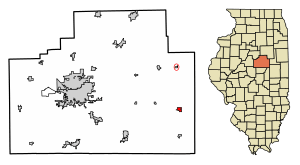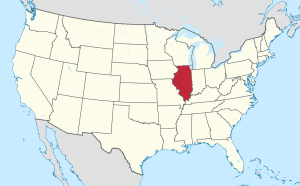Saybrook, Illinois facts for kids
Quick facts for kids
Saybrook, Illinois
|
|
|---|---|

Location of Saybrook in McLean County, Illinois.
|
|

Location of Illinois in the United States
|
|
| Country | United States |
| State | Illinois |
| County | McLean |
| Township | Cheney's Grove |
| Area | |
| • Total | 0.83 sq mi (2.15 km2) |
| • Land | 0.80 sq mi (2.08 km2) |
| • Water | 0.03 sq mi (0.07 km2) |
| Elevation | 807 ft (246 m) |
| Population
(2020)
|
|
| • Total | 654 |
| • Density | 815.46/sq mi (314.94/km2) |
| Time zone | UTC-6 (CST) |
| • Summer (DST) | UTC-5 (CDT) |
| ZIP code |
61770
|
| Area code(s) | 309 |
| FIPS code | 17-67912 |
| GNIS ID | 2399767 |
| Wikimedia Commons | Saybrook, Illinois |
Saybrook is a small village located in McLean County, Illinois, United States. In 2020, about 654 people lived there. It is part of the larger Bloomington–Normal area.
People in Saybrook often call it the "City of Shade and Water." It is thought to be named after Old Saybrook, Connecticut.
Contents
Saybrook's Location and Landscape
Saybrook is in the southeastern part of McLean County. It is about 27 miles (43 km) east of Bloomington, which is the main city of the county. The village is also 15 miles (24 km) northeast of Farmer City and 10 miles (16 km) southwest of Gibson City.
The village covers a total area of about 0.83 square miles (2.15 square kilometers). A small part of this area, about 0.03 square miles (0.07 square kilometers), is water. The Sangamon River flows through the southwest part of Saybrook. At this point, the river is more like a small creek. Saybrook is the first community located along the Sangamon River.
The Story of Saybrook: A Look Back
How Saybrook Began
Saybrook was officially started on March 4, 1856, by a man named Isaac M. Polk. He was born in Indiana and did not stay in McLean County for very long.
Before Polk, Jonathan Cheney arrived in the area in 1825. He built a cabin across the river from where Saybrook is today. Later, in 1833, Robert Cunningham built a mill that used water power on the Sangamon River. This mill was later replaced by one that used steam. By 1857, Saybrook had a saw mill, a blacksmith shop, a carpenter shop, one store, and eight homes. The wooded area along the Sangamon River, known as Cheney's Grove, attracted many early settlers. The township where the town is located was named Cheney's Grove after this woodland. The name "Saybrook" was chosen in 1865. It is believed that settlers from Old Saybrook, Connecticut picked this name.
The town of Saybrook officially became a village on May 29, 1866.
Saybrook's First Town Plan
The original town of Saybrook was quite small compared to other towns in McLean County. It was a simple square with four blocks, and each block had eight lots. The first town plan was laid out over older roads and property lines. These older lines were at a different angle than the new town plan. Some old lines can still be seen on the 1856 map. The first town did not have a central square or any special features. Some stories say this was to make the town seem bigger to people who wanted to build railroads. However, this is probably not true. The railroad builders knew Saybrook well. In 1866, the town council added a large new area to the north and east of the original town.
Bringing the Railroad to Saybrook
The people of Saybrook knew their town needed a railroad to grow. The most likely railroad was the one that later became the Lake Erie and Western line. This railroad was planned to go straight east from Bloomington to Paxton. This meant it would probably miss Saybrook by several miles.
However, three brothers from the Cheney family, sons of Jonathan Cheney, helped change this. Haines Cheney, who was in the Illinois Senate, helped get the railroad's charter. To pay for the railroad, local towns and townships would sell bonds. Taxpayers would eventually pay back these bonds. Two other Cheney brothers, Jonathan H. Cheney and William H. Cheney, were on the railroad's board of directors. William H. Cheney owned a lot of land in Cheney's Grove Township. William H. Riggs, who was in charge of Cheney's Grove Township, was also on the board.
Cheney's Grove Township voted to provide $50,000 in bonds. The town of Saybrook added another $10,000 in bonds. With this much support, the railroad's path was changed. It was moved to go through the town of Saybrook. In November 1871, when the train tracks reached Saybrook, a big celebration was held. People brought a bottle of champagne. Instead of smashing it, they carefully opened it to drink later. The new Christian church in Saybrook invited visitors from Bloomington to their first service. They even announced there would be a special train "on our railroad" for them.
Life After the Railroad Arrived
Once the railroad was built in 1870, Saybrook grew very quickly. It soon became the biggest place for shipping grain in eastern McLean County. A train station and its grounds were built just south of the original town. The railroad tracks also crossed over the Sangamon River.
In 1870, Thomas Holloway built a large brick hotel called the Union House Hotel. In 1872, a local newspaper started. Many new houses and stores were built. By 1900, 879 people lived in Saybrook. In the 1900s, Saybrook's population went down by about 15 percent. By 2000, Saybrook was smaller than it had been a century before.
Saybrook's Population Over Time
| Historical population | |||
|---|---|---|---|
| Census | Pop. | %± | |
| 1860 | 69 | — | |
| 1870 | 389 | 463.8% | |
| 1880 | 734 | 88.7% | |
| 1890 | 861 | 17.3% | |
| 1900 | 879 | 2.1% | |
| 1910 | 805 | −8.4% | |
| 1920 | 752 | −6.6% | |
| 1930 | 746 | −0.8% | |
| 1940 | 779 | 4.4% | |
| 1950 | 758 | −2.7% | |
| 1960 | 859 | 13.3% | |
| 1970 | 814 | −5.2% | |
| 1980 | 882 | 8.4% | |
| 1990 | 767 | −13.0% | |
| 2000 | 764 | −0.4% | |
| 2010 | 693 | −9.3% | |
| 2020 | 654 | −5.6% | |
| Decennial US Census | |||
In 2000, there were 764 people living in Saybrook. These people lived in 325 households, and 219 of these were families. The village had about 964 people per square mile (372 people per square kilometer). There were 340 homes in total.
Most people in Saybrook were White (98.82%). A small number were African American (0.13%) or Asian (0.13%). About 0.92% were from two or more races. Hispanic or Latino people made up 0.26% of the population.
In terms of age, 25.3% of the people were under 18 years old. About 15.7% were 65 years or older. The average age was 39 years. For every 100 females, there were about 90.5 males.
The average income for a household in Saybrook was $37,778. For families, the average income was $43,750. About 8.6% of all people and 7.7% of families lived below the poverty line. This included 12.6% of those under 18 and 8.0% of those 65 or older.
Famous People from Saybrook
- Blake Feese, a professional racing driver.
- Ele Stansbury, who served as the Indiana Attorney General from 1917 to 1921.
See also
 In Spanish: Saybrook (Illinois) para niños
In Spanish: Saybrook (Illinois) para niños

